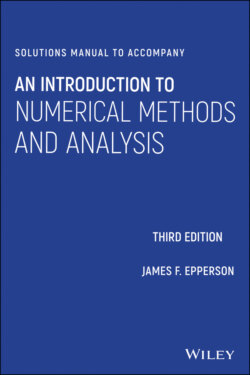Читать книгу Solutions Manual to Accompany An Introduction to Numerical Methods and Analysis - James F. Epperson - Страница 5
Preface to the Solutions Manual for the Third Edition
ОглавлениеThis manual is written for instructors, not students. It includes worked solutions for many (roughly 75%) of the problems in the text. For the computational exercises I have given the output generated by my program, or sometimes a program listing. Most of the programming was done in MATLAB, some in FORTRAN. (The author is well aware that FORTRAN is archaic, but there is a lot of “legacy code” in FORTRAN, and the author believes there is value in learning a new language, even an archaic one.) When the text has a series of exercises that are obviously similar and have similar solutions, then sometimes only one of these problems has a worked solution included. When computational results are asked for a series of similar functions or problems, only a subset of solutions are reported, largely for the sake of brevity. Some exercises that simply ask the student to perform a straightforward computation are skipped. Exercises that repeat the same computation but with a different method are also often skipped, as are exercises that ask the student to “verify” a straight‐forward computation.
Some of the exercises were designed to be open-ended and almost “essay‐like.” For these exercises, the only solution typically provided is a short hint or brief outline of the kind of discussion anticipated by the author.
In many exercises the student needs to construct an upper bound on a derivative of some function in order to determine how small a parameter has to be to achieve a desired level of accuracy. For many of the solutions this was done using a computer algebra package and the details are not given.
Students who acquire a copy of this manual in order to obtain worked solutions to homework problems should be aware that none of the solutions are given in enough detail to earn full credit from an instructor.
The author freely admits the potential for error in any of these solutions, especially since many of the exercises were modified after the final version of the text was submitted to the publisher and because the ordering of the exercises was changed between editions. While we tried to make all the appropriate corrections, the possibility of error is still present, and undoubtedly the author's responsibility.
Because much of the manual was constructed by doing “copy‐and‐paste” from the files for the text, the enumeration of many tables and figures will be different. I have tried to note what the number is in the text, but certainly may have missed some instances.
Suggestions for new exercises and corrections to these solutions are very welcome. Contact the author at jfe@ams.org or jfepperson@gmail.com .
Differences from the text The text itself went through a copy‐editing process after this manual was completed. As was to be expected, the wording of several problems was slightly changed. None of these changes should affect the problem in terms of what is expected of students; the vast majority of the changes were to replace “previous problem” (a bad habit of mine) with “Problem X.Y” (which I should have done on my own, in the first place). Some punctuation was also changed. The point of adding this note is to explain the textual differences which might be noticed between the text and this manual. If something needs clarification, please contact me at the above email.
